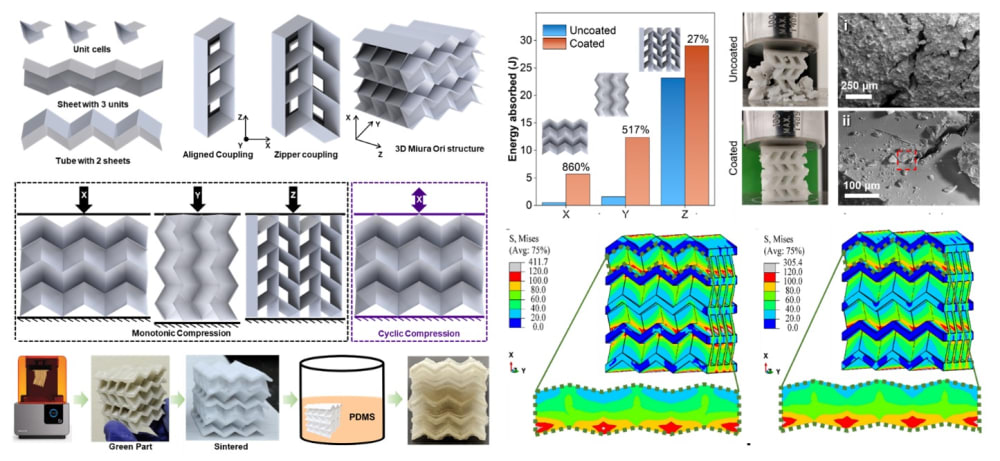Our design introduces a unique approach to transform inherently brittle materials, such as ceramics, into adaptable and tough structures through the ancient art of origami, enabled by additive manufacturing (AM) and elastic coating. Traditionally, brittle materials fail catastrophically under stress, which limits their use in applications that require damage-tolerance behavior. This limitation is particularly critical in areas such as prosthetics, medical devices, and ballistic armor, where materials must combine high strength, corrosion resistance, and biocompatibility with a more controlled and graceful failure mode.
Our innovation directly addresses this challenge by engineering ceramic structures based on the Miura-ori, a natural origami pattern known for its multi-stability, auxetic behavior (negative Poisson's ratio), and tunable mechanical characteristics. These complex ceramic origami structures are fabricated using slurry-based stereolithography (SLA) 3D printing, a novel method that enables the creation of intricate designs previously impossible with traditional ceramic machining or casting, due to the brittle nature and high melting temperatures of ceramics. Our key advancement lies in coating the 3D-printed Miura-ori ceramic structures with a biocompatible hyperelastic polymer, polydimethylsiloxane (PDMS). This polymer coating, applied uniformly via dip coating under vacuum, effectively mimics the toughening mechanisms found in nature, such as nacre (mother-of-pearl), where a soft organic matrix reinforces brittle mineral platelets to enhance toughness.
A primary benefit of this design is the diversion of catastrophic failure into a graceful failure mode for brittle ceramics. Both experimental results and numerical simulations consistently demonstrate that PDMS-coated origami structures exhibit significantly greater toughness than their uncoated counterparts, with enhanced energy absorption varying depending on the loading direction. The most substantial improvement was observed in the least stiff direction (X-direction), indicating the coating’s ability to prevent premature catastrophic failure. The elastomeric coating effectively hinders and stops crack propagation and interconnection within the brittle ceramic. The origami geometry itself allows for orientation-dependent mechanical properties, with the structure exhibiting maximum strength and toughness in the Z-direction and being least stiff in the X-direction. The addition of the coating enhances this directional tunability, allowing the structure to be tailored for specific mechanical requirements. Moreover, under cyclic compression, the coated structures maintain structural integrity even beyond the failure threshold of the uncoated ones, particularly in the X-direction. This indicates enhanced flexibility and fatigue resistance, making the system promising for load-bearing applications that demand both toughness and resilience.
This design not only unlocks the potential of ceramics for flexible and adaptable structures but also offers a novel pathway for creating robust, lightweight, and resilient structures with materials that are generally brittle. Future work will involve optimizing the dimensional parameters of the Miura-ori unit cell to tailor mechanical responses for specific applications, such as maximizing energy absorption, impact resistance, or crack resistance, potentially leading to more compact and lighter designs without compromising strength.
Like this entry?
-
About the Entrant
- Name:Muhammad M Rahman
- Type of entry:teamTeam members:
- Md. Shajedul Hoque Thakur
- Software used for this entry:ABAQUS Finite Element Analysis software
- Patent status:none


